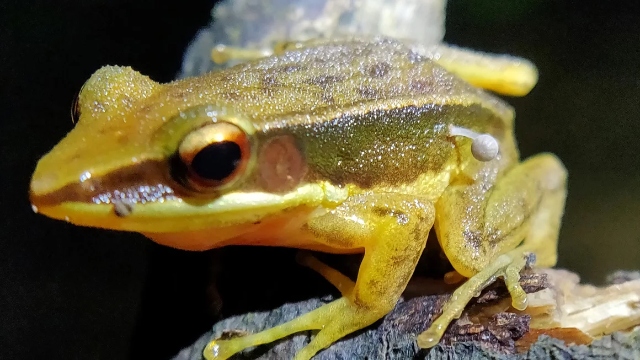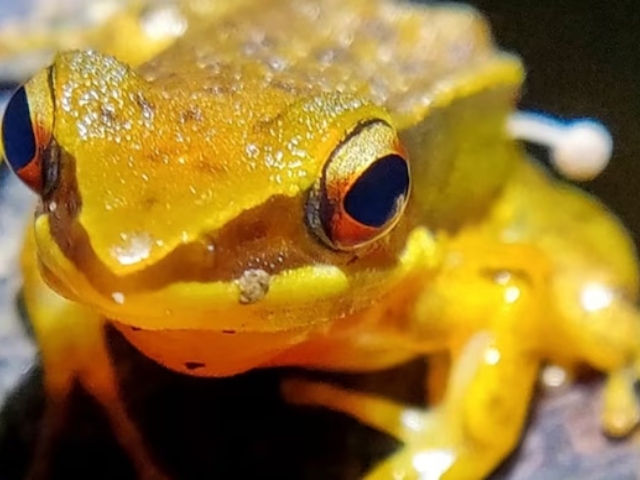
-
Now You’re Never Going To Stop Thinking About This Living Frog With A Mushroom Sprouting Out Of Its Body
01 Mar 2024 by Tayla in Animals, Nature, Science, Tech/Sci, World
[imagesource: Lohit Y.T]
While observing an army of golden-backed frogs at a roadside pond in Karnataka, India, a team of naturalists noticed something rather unusual about one of the little hoppers.
Upon closer inspection, it was observed that one of the amphibians sported a miniature mushroom growing from its flank.
How an otherwise healthy-seeming frog came to grow its fungi companion – an occurrence that’s never been documented before – has left scientists completely baffled, according to a note published in January in the journal Reptiles and Amphibians.
It is odd. The frog is fully alive, AKA not decaying in death, and yet it has some fungi hitching a ride on its body.

Image: Lohit Y.T
Lohit Y T, a rivers and wetlands specialist with World Wildlife Fund-India in Bengaluru, told CNN that when he first observed the frog with the mushroom, “I was amazed and intrigued by the sight”.
“My thought was to document it, as this phenomenon is something we have never heard of. We just wanted this to be a rare incident and not a dangerous phenomenon for the frog.”
The species, identified as Rao’s intermediate golden-backed frog, scientifically termed Hylarana intermedia, thrives abundantly in the southwestern Indian states of Karnataka and Kerala. These frogs are diminutive, growing to just 7.4 centimetres.
As the naturalists watched the frog with the fungal growth, the animal moved from the center of the twig it sat upon to the very tip, turning around and changing positions, but the mushroom remained perfectly in place, Y T said. The group did not touch the frog.
Through pictures, mycologists were able to identify the mushroom growing out of the frog’s flank as a common bonnet, part of the Mycena genus, a type of fungi that mostly grows on rotting wood from dead trees, the authors wrote in the published paper.
The fungus is a saprotrophic decomposer, a mushroom that typically gets its nutrients from dead or decaying organic matter — but a 2023 study found the mushroom could evolve to thrive on living plants as well.
The study conducted in 2023 also proposed that the Mycena fungus could potentially establish a symbiotic relationship with living plants or trees. This would entail mutual benefits, where both the plant and the fungus derive advantages from the association. The fungi would extract nutrients from the plant host while also transferring essential elements to it.
There’s no saying whether this sort of symbiotic relationship is occurring between the frog and the fungus, though.
Strangely, not one of the naturalists who discovered the amphibian in June 2023 thought to collect it for further study, so neither the cause of the phenomenon nor the fate of the frog is known.
Now this fungi frog will haunt me till the day I die.
[source:cnn]
Latest News
-
Powerful South African Short Film ‘The Last Ranger’ Scoops Up Awards And International Praise
[imagesource: Cindy Lee Director/Facebook] A compelling South African short film, The L...
-
Caprice Summer Has Started With Brunch (But Better) This Saturday + Other Lush Camps Bay Parties
[imagesource: Instagram/cafecaprice] Is it just me or has Summer been taking its sweet ...
-
Notre-Dame Cathedral In Paris Restored And Ready For Grand Reopening After Devastating Fire
[imagesource:wikimedia] After five years of work and millions in donations, The Notre-D...
-
Self-Destructing Number Plates: The Future Of Gauteng’s Roads Or Spy-Tech Fantasy?
[imagesource:worldlicenseplates.com] What sounds like a James Bond movie is becoming a ...
-
I Changed My Relationship With Food And You Won’t Believe What Happened Next
[imagesource:supplied] As the festive season approaches, it's time to deck the halls, g...
-






























